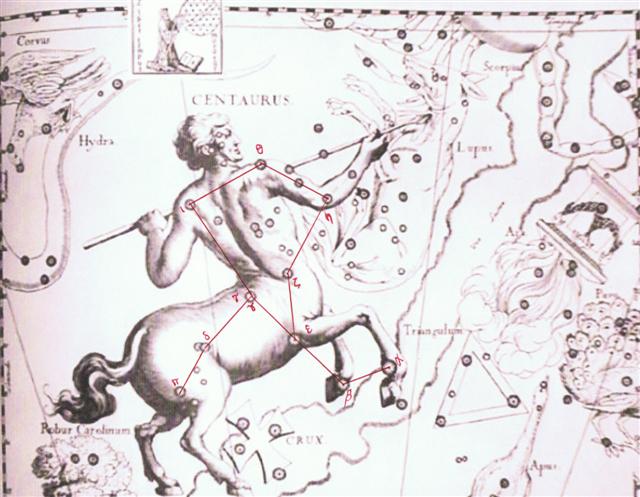6. Allen: "Burritt located this [β] near the right fore leg, calling it Agena, but gave no meaning or derivation of the word, and I have not found it elsewhere; Bayer placed it on the left hind quarter.* * Allen, who correctly deciphered the meaning of Bungula ... failed to recognize Agena as a similar compound, a and gena, the knee. - Donald H. Menzel, 1963." "Bailey's edition of Ulug Beg's catalogue gives it [α] as Rigil Kentaurus, from Al Rijl al Kentaurus, the Centaur's Foot; describing it as on the toe of the right front hoof, and Bayer so illustrated it. Chrysococca had the synonymous πουσ κοντουροσ; and our Century Dictionary retains Rigel, although this is better known for the bright star in Orion. Burritt located on the left fore hoof a 4th magnitude star that he wrongly lettered α; and above the pastern our 1st magnitude, also lettered α, with the title Bungula, which I find only with him and the Standard Dictionary. He gives no explanation of this, nor can I trace it further; it may be a word specially coined by Burritt from β and ungula, the hoof, although even in this the letter is wrong." In other words, Burritt had bungled. But Hevelius has correctly α above the pastern and β on the other front hoof:
Back to Allen's comments regarding β: "Hadar and Wazn, Ground and Weight, seem to have been applied without much definiteness to α and β of this constellation, and to stars in Argo, Columba, and Canis Major, probably on account of their proximity to the horizon; the meridian altitude of β, 1000 years ago at Cairo, in 30º of north latitude, being only 4º. Hyde, however, said that α and γ were the stars referred to by these Arabic titles. The Chinese call β Mah Fuh, the Horse's Belly. This and α are the Southern Pointers, i.e. towards the Southern Cross, often regarded as the Cynosure of the southern hemisphere. One ancient name for Polaris was Cynosūra, from the Greek κυνόσουρα 'the dog’s tail' (reflecting a time when the constellation of Ursa Minor 'Little Bear' was taken to represent a dog), whence the English word cynosure. (Wikipedia) The Bushmen of South Africa knew them as Two Men that once were Lions; and the Australian natives as Two Brothers who speared Tchingal to death; the eastern stars of the Cross being the spear points that pierced his body." Beta Centauri is well known in the Southern Hemisphere as the inner of the two 'Pointers' to the Southern Cross. A line made from the other pointer, Alpha Centauri, through Beta Centauri leads to within a few degrees of Gacrux, the star at the top of the cross. Using Gacrux, a navigator can draw a line with Acrux to effectively determine south. The indigenous Boorong people of northwestern Victoria named it as Bermbermgle (together with α Cen), two brothers who were noted for their courage and destructiveness, and who spear and kill Tchingal, 'The Emu' (Coalsack Nebula). The two brothers in Wotjobaluk people is Bram-bram-bult. (Wikipedia)
(A depiction of the 'Emu in the sky', which is an Australian Aboriginal constellation consisting of dark clouds rather than of stars. The European constellation on the right is Crux or the Southern Cross, and on the left is Scorpius. The head of the emu is the Coalsack.) |

